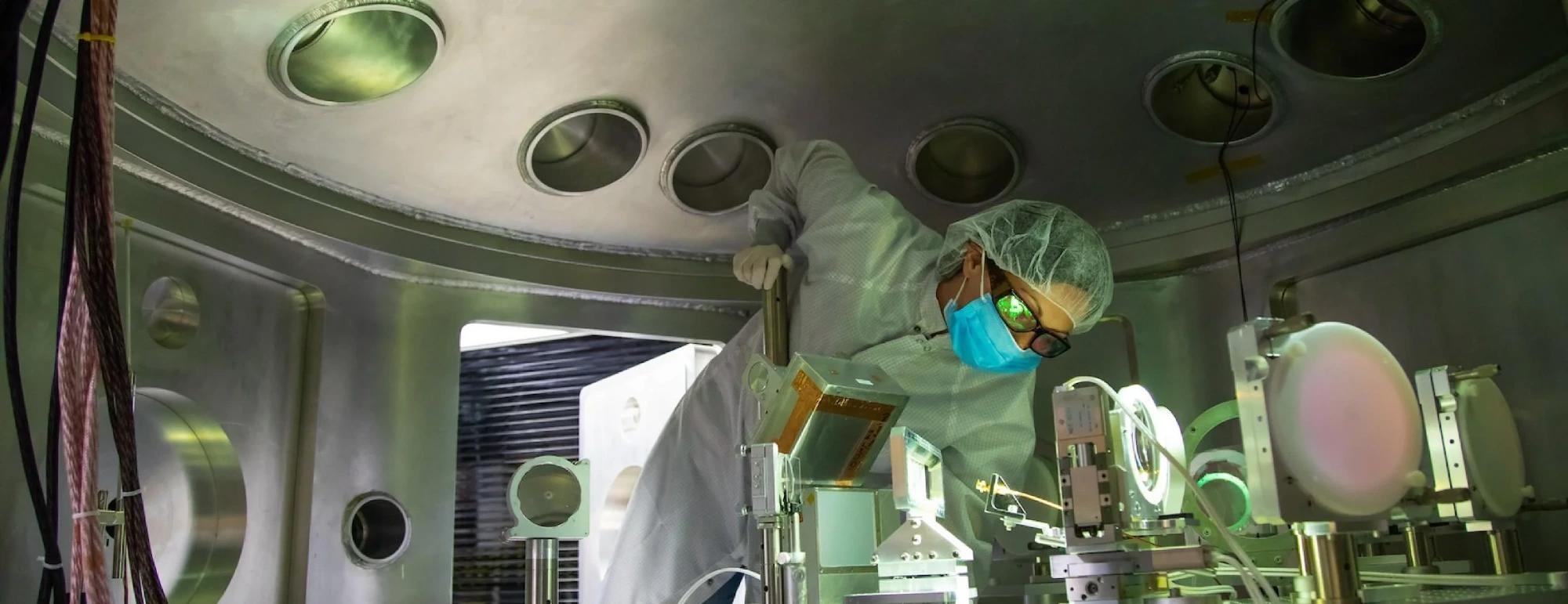Recent research carried out at the SLAC National Accelerator Laboratory of the Department of Energy sheds light on the peculiar behavior of gold when exposed to high-energy laser pulses.
 At the Matter in Extreme Conditions experimental hutch, the team targeted thin gold films with optical laser pulses, then used super-fast X-ray pulses from LCLS to take atomic-level snapshots of how the material responded. Image Credit: Dawn Harmer/SLAC National Accelerator Laboratory.
At the Matter in Extreme Conditions experimental hutch, the team targeted thin gold films with optical laser pulses, then used super-fast X-ray pulses from LCLS to take atomic-level snapshots of how the material responded. Image Credit: Dawn Harmer/SLAC National Accelerator Laboratory.
Some materials, like silicon, disintegrate quickly when exposed to high laser excitation. On the other hand, gold becomes harder and more resilient. This is due to a change in the phonon behavior or how the gold atoms vibrate in unison.
Our findings challenge previous understandings by showing that, under certain conditions, metals like gold can become stronger rather than melting when subjected to intense laser pulses. This contrasts with semiconductors, which become unstable and melt.
Adrien Descamps, Lead Researcher and Graduate Student, Queen’s University Belfast
Simulations have suggested the possibility of this phenomenon, called phonon hardening, for decades. This phonon hardening has now been revealed by the researchers using the Linac Coherent Light Source (LCLS) at SLAC. The group released their findings in Science Advances.
It’s been a fascinating journey to see our theoretical predictions confirmed experimentally. The precision with which we can now measure these phenomena at LCLS is astonishing, and it opens up new possibilities for future research in material science. The precision with which we can now measure these phenomena at LCLS is astonishing, and it opens up new possibilities for future research in material science.
Emma McBride, Collaborator, Researcher and Panofsky Fellow, High Energy Density Science (HEDS), SLAC
Using ultrafast X-Ray pulses from LCLS, the team captured atomic-level images of the material's response to optical laser pulses directed at thin gold films at the Matter in Extreme Conditions experimental hutch. By observing subtle changes and capturing the exact moment when the phonon energies of gold increased, researchers were able to provide concrete evidence of phonon hardening through this high-resolution glimpse into the atomic world of gold.
McBride says, “We used X-Ray diffraction at LCLS to measure the structural response of gold to laser excitation. This revealed insights into the atomic arrangements and stability under extreme conditions.”
Researchers discovered that the forces holding gold's atoms together get stronger when the metal absorbs extremely high-energy optical laser pulses. The atoms vibrate more quickly as a result of this alteration, which may have an impact on the melting point and how the gold reacts to heat.
This work resolves a long-standing question about the ultrafast excitation of metals and shows that intense lasers can completely alternate the response of the lattice.
Siegfried Glenzer, Director, High Energy Density Division, SLAC
Similar phenomena may occur in other metals, such as copper, platinum, and aluminum, according to researchers. More investigation may provide light on how metals respond to harsh environments, which will help in the creation of materials with higher resilience.
Descamps says, “Looking ahead, we’re excited about the potential to apply these findings to more practical applications, such as in laser machining and material manufacturing, where understanding these processes at the atomic level could lead to improved techniques and materials. We’re also planning more experiments and hoping to explore these phenomena across a wider range of materials. It’s an exciting time for our field, and we’re looking forward to seeing where these discoveries take us.”
LCLS is a user facility of the DOE Office of Science. The study was funded in part by the Office of Science (BES and FES).
Journal Reference:
Descamps, A., et.al (2024) Evidence for phonon hardening in laser-excited gold using x-ray diffraction at a hard x-ray free electron laser. Science Advances. doi.org/10.1126/sciadv.adh5272